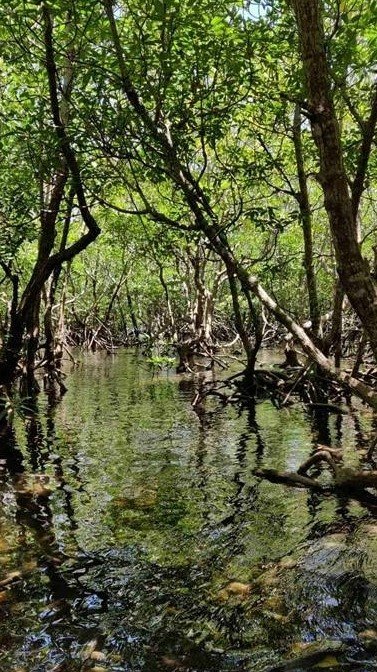|
Cycle 9 (2020 Deadline)
Assessment and comparison of recovery of biodiversity and carbon sequestration in Philippine mangroves among natural, replanted and naturally-recolonized mangrove stands
PI: Severino Salmo III (sgsalmo@up.edu.ph), University of the Philippines Diliman - Institute of Biology
U.S. Partner: Richard MacKenzie, United States Department of Agriculture/United States Forest Service
Project Dates: July 2021 - March 2024
Project Overview
 | | Planted mangrove sampling site in Oriental Mindoro. Photo credit: Dr. Salmo. |
The capacity of mangroves to render ecosystem services depends on their spatial extent, ecosystem health, and forest development. Intact mangroves have high primary productivity that results in elevated carbon stores and provides food for mangrove-specialist fauna (e.g., crabs, shrimp). When disturbed, mangroves lose or reduce their ecosystem functionality. In restored mangroves that have been replanted, the recovery of vegetation structure, productivity, carbon storage, and fauna are thought to follow a “chronosequence” in which these ecosystem attributes increase with mangrove age/maturity.
In the Philippines, most restoration projects have been ineffective, resulting in stunted growth and poor survival. It will take a longer period before these restored mangroves match the ecosystem attributes of an intact natural mangroves, or they could fail altogether. The recovery of naturally-recolonized abandoned fishponds may follow a similar chronosequence as replanted mangroves. This project compared carbon sequestration, burial, sources, greenhouse gas emissions, and biodiversity among intact mangroves, replanted mangroves, and fishponds that have been recolonized.
The PEER team undertook their research in the highly diverse Mindoro Oriental and Panay Islands, which have experienced massive mangrove losses from fishponds. The project also included a science-community-policy linkage, in which technical research was conducted in collaboration with community groups and undergraduate and graduate students were trained in the assessment of various types of mangrove stands.
Final Summary of Project Activities
The researchers conducted 13 total field work visits, six in Oriental Mindoro, four in Prieto Diaz (Sorsogon), and three in Ormoc City (Leyte). This included sediment sampling for carbon stock assessment, water and sediment sampling for biodiversity assessment (using eDNA metabarcoding), vegetation assessment, water quality analyses, litterfall collection, PhotosynQ analyses, a litter decomposition experiment, leaf and sediment collection (for nutrient analyses), and lichen and mollusk assessments. The activities were conducted by the PI Dr. Sev Salmo, research assistants, students from several universities, local guides, and municipal representatives and were held periodically at approximately six-month intervals to account for seasonal variations at the study sites.
Monthly litter samplings were conducted in Sorsogon (by local guides) and Ormoc (by University of the Philippines Tacloban College students) for 12 months from the trap nets set up at each vegetation plot. In Ormoc, a PhD student conducted seedling growth and physiology assessments using PhotosynQ. Students from Mindoro State University also conducted their own sampling activities in the project’s vegetation plots in Oriental Mindoro. Additional field activities were conducted in the project sites of Oriental Mindoro to collect sediment samples for eDNA metabarcoding and measure greenhouse gas emissions.
The PEER project researchers conducted a carbon stock assessment using the LOI method, undertook a litterfall analysis of the Sorsogon monthly sample, and partnered with several research centers to conduct eDNA metabarcoding analyses. In August-September 2023, the PI Dr. Salmo and Ms. Maria Elisa Gerona-Daga spent three weeks at the University of Wisconsin - Milwaukee for the estimation of carbon accumulation rates in mangrove sediments using Pb210. The visit was arranged by U.S. partner Dr. Richard Mackenzie.
The PEER team presented their work through several workshops and conferences, including 6th Mangrove Macrobenthos Management Meeting, the 17th National Symposium in Marine Science and 55th Federation of Institutions for Marine and Freshwater Sciences. They hosted several trainings, including ones related to mangrove assessments, blue carbon studies, eDNA metabarcoding analyses, and roadmapping activities for Philippine mangroves. The project’s exit conference: “Hopespotting: Recognizing Mangrove Hotspots for Conservation and Restoration” included technical presentations from the research assistants and students, a workshop on mangrove mapping, and lectures from two guest speakers.
The researchers have already published several articles in relation to their work and the project developed an interactive online platform that integrates and summarizes the project’s research outputs for biodiversity, social, policy, with an integrated real-time mangrove status reporting form and data dashboard, which should be especially helpful for their local municipal government partners in conducting their own mangrove monitoring in the years to come. The municipal government of Masinloc, Zambales, issued a municipal resolution expressing gratitude and appreciation to the accomplishments of the project and adopted the Online Mangrove Data Monitoring Dashboard for systematic mangrove assessment and monitoring. Mayor Arsenia Limen encouraged the other municipal mayors in Zambales to adopt the dashboard.
The PEER team received three additional grants for ongoing work, with $40,000 total, as a result of the project. The PI and a U.S. Fulbright Program visiting professor developed a new graduate course on Blue Carbon and Coastal Ecosystem Conservation that began in the 2023-2024 academic year. The PI also developed a new graduate course on Wetland Ecology to discuss biology/ecology of the Philippine wetlands as well as the state of research, issues/threats, conservation and restoration approaches, and policy recommendations.
Publications
Christine B. Corcino Russel, Maria Elisa B. Gerona-Daga, Shaina C. Samoza, John Kenneth R. Fraga, and Severino G. Salmo. 2023. Status, limitations, and challenges of blue carbon studies in the Philippines: A bibliographic analysis, Regional Studies in Marine Science 62: 102916. https://doi.org/10.1016/j.rsma.2023.102916.
Maria Elisa B. Gerona-Daga and Severino G. Salmo III. 2022. A systematic review of mangrove restoration studies in Southeast Asia: Challenges and opportunities for the United Nation’s Decade on Ecosystem Restoration. Frontiers in Marine Science 1865. https://doi.org/10.3389/fmars.2022.987737
S. Kannan, S. Balamurugan, P. Ragavan, B. Deivasigamani, A.K.S. Wee, S.G. Salmo III, M. Basyuni, and T. Kajita. 2022. eDNA envisaged conservation of IUCN threatened taxa of the tropical mangrove ecosystems. IOP Conference Series: Earth and Environmental Science, Volume 1115, 4th International Conference on Natural Resources and Technology 29-30 August 2022 Sumatera Utara, Indonesia. https://iopscience.iop.org/article/10.1088/1755-1315/1115/1/012032/meta
Back to PEER Cycle 9 Grant Recipients
|
|
|
|




